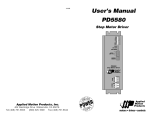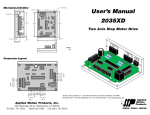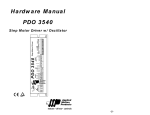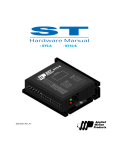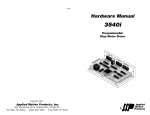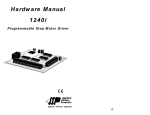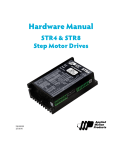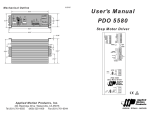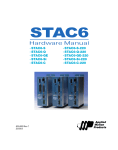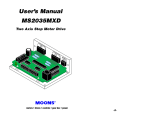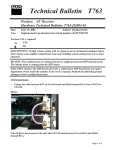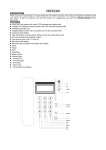Download User`s Manual Model 1030
Transcript
6/15/98 User's Manual Model 1030 Step Motor Driver Copyright 1998 Applied Motion Products, Inc. 404 Westridge Drive Watsonville, CA 95076 Tel (408) 761-6555 (800) 525-1609 Fax (408) 761-6544 motors • drives • controls -15- Technical Specifications Introduction Amplifiers Thank you for selecting an Applied Motion Products motor control. We hope our dedication to performance, quality and economy will make your motion control project successful. Inputs Physical Dual, bipolar H-bridge, pulse width modulated switching at 20kHz. 12-30 VDC input. 0.2 - 1.0 amp/phase output current, factory configured. 30 watts maximum output power. Automatic idle current reduction, reduces current after one half second. Step and direction, optically isolated. Inputs can be wired for sinking, sourcing or differential signals. 5-12V logic configuration has 680 ohms input impedance 24V logic configuration has 2200 ohms input impedance Motor steps on rising edge of step line. 10 µsec minimum low pulse. 50 µsec minimum set up time for direction signal. Constructed on .062" thick printed circuit board. Two mounting holes, Ø 0.156". Use plastic standoffs or spacers. Overall size with vertical headers: 1.6 x 2.25 x 0.77 inches. Overall size with horizontal headers: 1.6 x 2.55 x 0.77 inches. See page 13 for detailed drawing. Ambient temp range (operating): 0 - 70˚C. Connectors Latching, polarized headers. Vertical header configuration: Motor: 5 position. Molex/Waldom part number 22-23-2051. Input: 6 position. Molex/Waldom part number 22-23-2061. Horizontal header configuration: Motor: 5 position. AMP part number 640457-5. Input: 6 position. AMP part number 640457-6. Mating Mating connectors and standoffs are only supplied with samples. Connectors • Contact: AMP part number 770666-1 (accepts AWG 22-26 wire) • 5 Position Housing (for motor): AMP number 770602-5 • 6 Position Housing (for inputs): AMP number 770602-6 You will need at least 11 contacts for each drive. Note: AMP is a connector company, not to be confused with Applied Motion Products, a motion control company. AMP parts can be purchased from an AMP distributor such as Allied (800-433-5700) or Digikey (800-DIGIKEY). -14- If there's anything we can do to improve our products or help you use them better, please call or fax. We'd like to hear from you. Our phone number is (800) 5251609 or you can reach us by fax at (408) 761–6544. You can also find useful information 24 hours a day at our web site: www.applied-motion.com. Features • • • • • • Drives NEMA motor sizes 14 through 23. Pulse width modulation switching amplifiers. Phase current from 0.2 to 1.0 amps (factory configured). Step and direction inputs, optically isolated, 5-24V logic (factory configured). Full, half or 1/4 step (factory configured) Automatic idle current reduction (factory configured) Block Diagram Step Sequencer step dir Optical Isolation Idle Current Reduction 12-30 VDC -3- Amplifier A+ AB+ B- to motor Getting Started Mechanical Outline To use your Applied Motion Products motor control, you will need the following: • a 12-30 volt DC power supply for the motor. Please read the section Choosing a Power Supply for help in choosing the right power supply. • a source of step & direction signals (indexer, oscillator or PLC). • a source of power to activate the optoisolation circuits. Many indexers & PLCs have power available for this purpose. If not, you may need a small 5 - 24 VDC power supply. • mating connectors (see page 14) • plastic spacers or stand-offs for mounting (see page 12) 2.00 pin 1 motor connector 0.125 0.70 0.80 1.60 pin 1 logic & power connector The sketch below shows where to find the important connection and mounting points. Please examine it now. 2.25 0.770 MAX current sensing resistor with vertical headers 0.062 connector motor mounting hole (.156") mounting hole (.156") connector power step direction current sensing resistor with horizontal headers voltage regulator (Beware, this part gets HOT!!!) -4- -13- .300 Mounting the Drive Connecting the Power Supply The 1030 has two .156" holes in the circuit board for mounting. In the design of this compact, low cost driver, it was necessary to route some circuit boards traces fairly close to the mounting holes. Therefore, you must only use plastic standoffs or spacers to support the 1030. You can drive #4 screws through the top of the board into a plastic spacer, but only if you put an insulating washer under the screw heads. An excellent way to mount the 1030 in your application is to use two Richco model LCBS-TF-6-01 spacers. The LCBS parts can be secured to your application with #6-32 screws. The 1030 then snaps onto the LCBS spacers, and no metal is in contact with the 1030. We use that configuration here at Applied Motion. Richco makes a wide variety of innovative pcb mounting hardware. Their phone number is 800-621-1892. Internet address is www.richcoplas.com. If you need information about choosing a power supply, please read Choosing a Power Supply located in the back of this manual. If your power supply does not have a fuse on the output or some kind of short circuit current limiting feature you need to put a 1 amp slow blow fuse between the drive and power supply. Install the fuse on the positive power supply lead. Connect the motor power supply positive (+) terminal to pin 2 of the power & logic connector. Connect power supply return (-) to pin 1. Be careful not to reverse the wires. Reverse connection will destroy your driver, void your warranty and generally wreck your day. Pin 2 (to power supply +) Pin 1 (to power supply -) Note: if you are using a motor with a shielded cable, connect the drain wire to pin 3. mounting hole (.156") mounting hole (.156") voltage regulator (Beware, this part gets HOT!!!) About the voltage regulator The 1030 requires 52 mA of power at 5 volts DC internally. We derive this 5V from the DC power that you provide for the motor. This is a low cost and compact technique, but does result in some heating of the voltage regulator. Don't be surprised if the temperature of the regulator reaches 90˚C. This will not affect the life of your drive, but if you accidentally touch the part, you won't be happy. You may add a heat sink to the voltage regulator if you wish. The metal tab is electrically connected to ground (power supply "-"). Never use your drive in a space where there is no air flow or where the air temperature is more than 70˚C. Never put the drive where it can get wet or where metal particles can get on it. -12- Pin 5 (motor A+) Pin 4 (motor A-) Pin 3 (ground) Pin 2 (motor B+) Pin 1 (motor B-) Connecting the Motor ✔ When connecting the motor, be sure that the power supply is off. ✔ Isolate & secure any unused motor leads. ✔ Never disconnect the motor while the drive is powered up. ✔ Never connect motor leads to ground or to a power supply. ✔ Use a polarized mating connector. You must now decide how to connect your motor to the drive. Four lead motors can only be connected one way. Please follow the sketch at the right. A+ A- Red 4 lead motor Blue Six lead motors can be connected in White Yellow series or center tap. In series mode, B+ Bmotors produce more torque at low speeds, but cannot run as fast as in the center tap 4 Leads configuration. In series operation, the motor should be operated at 30% less than the rated current to prevent overheating. Wiring diagrams for both connection methods are shown on the next page. -5- Grn/Wht ANC A+ 6 lead motor White Green A+ NC Red/ Wht Red NC = not connected B- Black NC Choosing a Power Supply Grn/Wht A- 6 lead motor White Green Red/ Wht Red Black BB+ NC = not connected B+ 6 Leads Series Connected NC 6 Leads Center Tap Connected Eight lead motors can also be connected in two ways: series and parallel. As with six lead motors, series operation gives you more torque at low speeds and less torque at high speeds. In series operation, the motor should be operated at 30% less than the rated current to prevent over heating. The wiring diagrams for eight lead motors are shown below. A+ Orange A+ Blk/Wht A- Blk/Wht 8 lead motor Org/Wht Org/ Wht A- Black Red B+ Red/ Wht Orange 8 lead motor Black Red Yellow Yel/ Wht B- Yel/ B+ Wht 8 Leads Series Connected Yel low Red/Wht B- 8 Leads Parallel Connected Step Table (half stepping) Step 0 is the power up state DIR=0 ccw Step 0 1 2 3 4 5 6 7 8 A+ 0 + + + 0 - A+ + 0 0 + + -6- B+ 0 0 + + + 0 B0 + + + 0 0 DIR=1 cw Voltage Chopper drives work by switching the voltage to the motor terminals on and off while monitoring current to achieve a precise level of phase current. To do this efficiently and silently, you’ll want to have a power supply with a voltage rating at least five times that of the motor. Depending on how fast you want to run the motor, you may need even more voltage than that. More is better, the only upper limit being the maximum voltage rating of the drive itself: 30 volts. If you choose an unregulated power supply, do not exceed 24 volts. This is because unregulated supplies are rated at full load current. At lesser loads, like when the motor’s not moving, the actual voltage can be up to 1.4 times the rated voltage. Current The maximum supply current you will need is the sum of the two phase currents. However, you will generally need a lot less than that, depending on the motor type, voltage, speed and load conditions. That's because the 1030 uses switching amplifiers, converting a high voltage and low current into lower voltage and higher current. The more the power supply voltage exceeds the motor voltage, the less current you’ll need from the power supply. We recommend the following selection procedure: 1. If you plan to use only a few drives, get a power supply with at least twice the rated phase current of the motor. 2. If you are designing for mass production and must minimize cost, get one power supply with more than two times the rated current of the motor . Install the motor in the application and monitor the current coming out of the power supply and into the drive at various motor loads. This will tell you how much current you really need so you can design in a lower cost power supply. If you plan to use a regulated power supply you may encounter a problem with current foldback. When you first power up your drive, the full current of both motor phases will be drawn for a few milliseconds while the stator fields are being established. After that the amplifiers start chopping and much less current is drawn from the power supply. If your power supply thinks this initial surge is a short circuit it may “foldback” to a lower voltage. With many foldback schemes the voltage returns to normal only after the first motor step and is fine thereafter. In that sense, unregulated power supplies are better. They are also less expensive. -11- Connecting A Pulse Source The following motors from Applied Motion Products are recommended for use with the 1030. All motors in the list have been tested with the 1030. Dynamic torque data is available. The 1030 inputs contain optical isolation circuitry to prevent the electrical noise inherent in switching amplifiers from interfering with your circuits. Winding Connection 4 lead center-end center-end center-end parallel parallel parallel center-end center-end parallel parallel parallel Max Torque oz-in 22 10 17 24 22 34 54 35 56 34 110 140 Current Amps 1.0 1.0 0.8 0.8 1.0 1.0 1.0 1.0 1.0 1.0 1.0 1.0 A schematic diagram of the input circuit is at the right. The wiring diagrams below show how to connect the drive to various pulse sources. Si-100 STEP+ STEP+ STEP- STEP- DIR+ DIR+ DIR- DIR- STEP+ STEPDIR+ DIR- 6 - DIR+ 5 - DIR4 - STEP+ 3 - STEP- Connecting Applied Motion Si-100 If you are using the Si-100, please purchase the 5V logic version of the 1030 +5V STEP+ DIR+ STEP STEP- DIR DIR- 1030 Size inches 1.38 x 1.38 x 1.57 1.65 x 1.65 x 1.34 1.65 x 1.65 x 1.54 1.65 x 1.65 x 1.85 1.65 x 1.65 x 1.30 1.65 x 1.65 x 1.54 1.65 x 1.65 x 1.85 2.22 x 2.22 x 1.5 2.22 x 2.22 x 2.0 2.22 x 2.22 x 1.54 2.22 x 2.22 x 2.13 2.22 x 2.22 x 2.99 SI-1 Motor Number 5014-842 5017-006 5017-009 5017-013 HT17-068 HT17-072 HT17-076 4023-839 4023-819 HT23-393 HT23-396 HT23-399 Optical isolation also allows the 1030 to accept step and direction signals ranging from 5 to 24 volts. Furthermore, the input signals can be sourcing (PNP) or sinking (NPN), depending on whether you "common" the STEP+ & DIR+ terminals (sinking) or the STEP- & DIR- signals (sourcing). You can also use differential signals. inside 1030 1030 Recommended Motors Connecting Applied Motion Si-1 If you are using the Si-1, please purchase the 5V logic version of the 1030 -10- -7- STEP- Y2 + DIRSTEP+ DIR+ Setting Phase Current 1030 NAiS FP0 PLC Y0 + 24VDC Power Supply – – Connecting Aromat (NAiS) Model FP0 PLC. The FP0 has sinking outputs. If you are using a PLC with 24V logic, please purchase the 24V logic version of the 1030 The phase current is set at the factory when the 1030 is manufactured. The only way to change it in the field is to change the current sensing resistors. If you feel that you must change the motor current, please follow these rules: 1. You must be skilled at soldering to change the resistors. You will void your warranty by modifying the drive, but at least if you are a skillful solderer, the drive should still work when you're done. 2. Choose the resistor value according to this formula: R = 0.4 / i, where R is the sensing resistor you need, and i is the current, in amps, that you want. 3. Use a resistors whose value is between 0.39 and 2.0 ohms. 4. Use 1 watt resistors, metal oxide type. Do not use wirewound resistors. current sensing resistor Selecting Between Full, Half and 1/4 Step The 1030 is configured at the factory for full, half or 1/4 step when it is manufactured. It is normally not possible to change this setting. However, if your 1030 was an engineering sample, we may have put the step sequencer chip in a socket. If this is the case, and you want to try a different step mode, give a us call - we can probably provide you with a different sequencing chip to put in the socket. Why would I prefer one mode over another? Full step mode will give you the most torque at low speeds. Full stepping also allows you to achieve higher speeds than half stepping if the speed of your pulse source is limited. For example, to drive a motor at 25 rev/sec in 1/4 step mode, you must supply step pulses to the 1030 at a rate of 20,000 Hz. To get 25 rev/sec in full step mode, only 5,000 pulses/sec are required. Half stepping is smoother and quieter than full step, so you should use half step mode whenever posssible. 1/4 stepping provides even more precise positioning and smoother motion than half stepping. For special options please call the factory. -8- current sensing resistor Idle Current Reduction The 1030 includes a feature that automatically reduces the motor current to 60% when the motor is not moving. This is known as idle current reduction. The idle current reduction is not adjustable by the user. However we can change the amount of current reduction during the manufacturing process. This is accomplished by changing the software in the sequencing chips. On sample drives, these chips are usually socketed, so units can be retrofitted if necessary. For special options please call the factory. -9-








